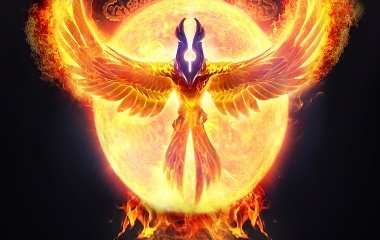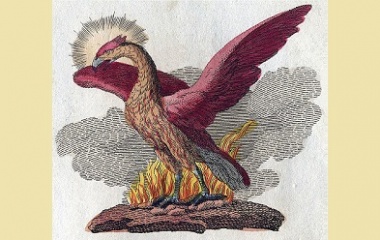What is a Phoenix?
The Phoenix is an immortal bird who embodies all the properties of the sun: its beautiful radiance, its warm but solitary nature, and most importantly, its cycle of death and rebirth.
Characteristics
Physical Description
Although the Phoenix is famous for its glorious appearance, scholars can’t seem to agree on a detailed description of that appearance.
By some accounts, the bird has gorgeous red and gold feathers, which makes sense, given its connection to the sun. Other ancient writers claim its feathers are colored by a priceless purple dye, which compliments its nickname: “the royal bird.” Still others claim that the Phoenix has the same lavish colors as the peacock, which shares its territory in India.
The Phoenix’s size and proportions are also debated. It may be as small as an eagle or larger than an ostrich. It usually has a long, swan-like neck, along with a crest of feathers on its head, large wings, and a long tail like a rooster or peacock. However, some writers have described it in the shape of a hawk, with scaly legs and sharp talons, or a heron, with long legs and a long sharp beak.
The one detail on which all writers agree is the Phoenix’s golden halo. This glorious bird reflects so much light that it appears to give off rays, like the sun.
Personality
“The royal bird” is a solitary creature, holding itself aloof from other birds that squawk and squabble. Likewise, it is rarely seen by humans.
Although reserved, the Phoenix is renowned for its virtues. It shows great respect for other noble creatures, like its parent Phoenix or powerful kings and gods, and it will help them out in times of need. It is also gentle towards inferior creatures, causing no harm to any of them.
Habitat and Behavior
Although the Phoenix’s legend comes from Greece, the bird itself was said to live in the jungles of India or Assyria. He constructs nests for himself, high above the world, and weaves precious herbs like frankincense, cinnamon, and myrrh into the twigs. Occasionally, he leaves his nest to stretch his radiant wings. When he flies, other birds are dazzled and form a parade behind him.
The Phoenix eats only precious herbs, refusing to eat messy fruits or nuts like other birds. He is strictly vegetarian, so no life is destroyed to fuel his own. In fact, some scholars believe the sun bird doesn’t need to eat at all.
He is immune to diseases, and no predators dare to attack him. Still, as he approaches five hundred years of age, his glorious eyes begin to dim, and his feathers start falling out. As he grows weaker, the bird begins transforming his nest into a funeral pyre or a round tomb, and on his five hundredth birthday, he sings a haunting funeral song to himself, then dies. Some stories claim that he erupts into flame, and his body is reduced to ashes. Others claim that he simply decays.
Either way, the Phoenix’s death is the beginning of his legend. Within a short time, a baby Phoenix will rise from his father’s ashes or carcass, a feat which has earned these brilliant birds a place among mythology’s most famous creatures.
To honor his father, the new Phoenix will carry his remains to a sun temple in Heliopolis, Egypt, as soon as his wings are strong enough for the long voyage.
Cultural Representation
History
In the 5th century BC, a Greek natural historian wrote the first known description of a Phoenix. However, he credited the idea of the bird to the Egyptian people, who had described it to him as a living symbol of the sun gods.
Greek scholars and poets latched onto the newborn Phoenix and added layers to its lore. Eventually, the revered sun bird was passed along to the Romans, then to Europeans, who used it as a symbol for royal dynasties, Jesus’ resurrection, and hope in general. The symbol proved to be so powerful that, like the Phoenix itself, it became immortal and passed from generation to generation without growing dim.
Similar birds can be found in Chinese, Japanese, Egyptian, Russian, and Native American legends.
Modern Appearances
Today, the Phoenix is so well known that it can be used as a passing reference in conversations, whenever a person has suffered from a setback and needs to recover.
It has also held onto its crown in the fantasy genre. CS Lewis, JK Rowling, Neil Gaiman, and Terry Pratchet have all welcomed the sun bird into their stories.
Phoenix






No comments:
Post a Comment